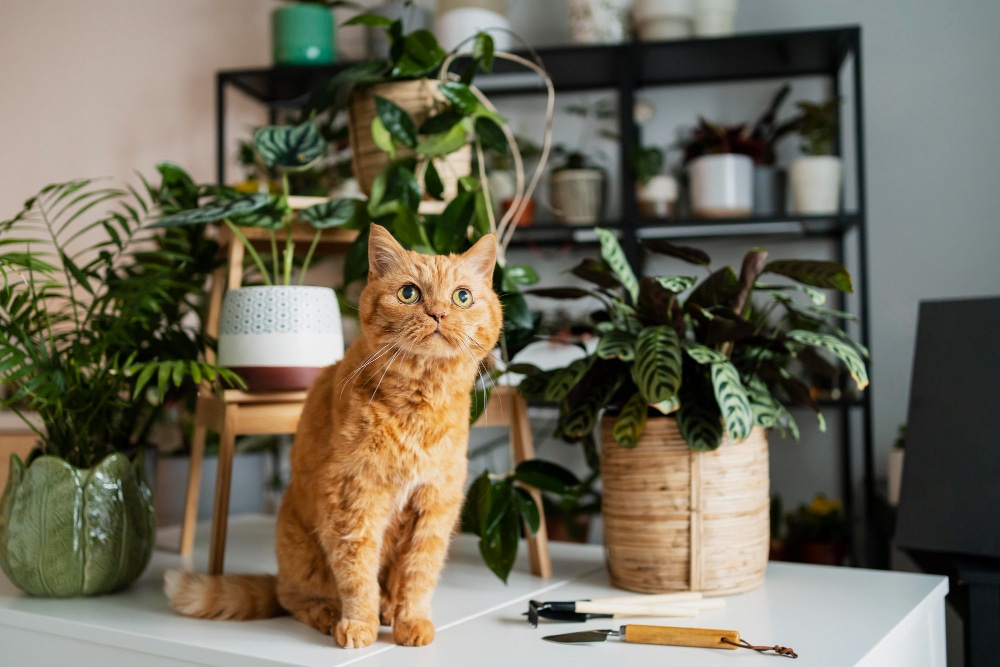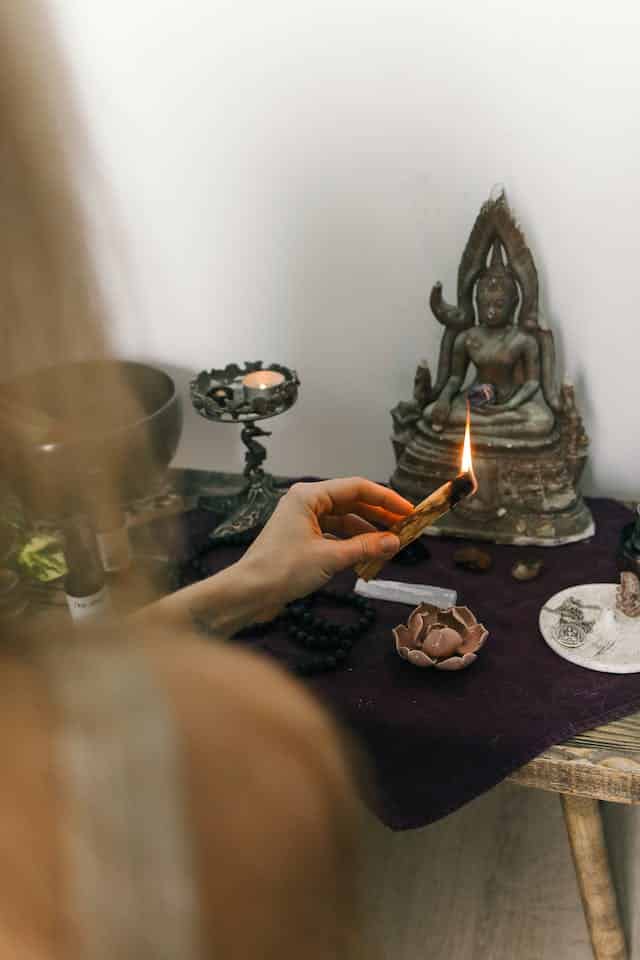
Burning sage, or smudging, is embraced by many for its ability to cleanse spaces of negative energy and promote healing and tranquillity.
However, for those of us with furry family members, particularly cats, it’s crucial to approach this practice with care. Cats have delicate respiratory systems, and the smoke from sage can impact them differently than it does us.
This article offers ten tips to ensure your smudging ritual is safe for your whiskered companions.
Tips for Burning Sage Around Cats

The benefits of burning sage can’t be ignored. But it can be a problem for your feline friends. Here are some tips that will help you safely burn sage around your furry friend.
1) Understanding Sage Smoke and Cats
Cats possess more sensitive respiratory systems than humans, making them more susceptible to the effects of smoke, including that from burning sage.
The particles and essential oils released during smudging can potentially irritate a cat’s airways, leading to discomfort or health issues. When considering whether burning sage is safe around pets, it’s crucial to understand the specific impact that sage smoke and the essential oils it contains can have on feline health.
Additionally, pet owners often wonder if their cats eat sage can be a problem. While small amounts of sage used in cooking might not be harmful, the concentrated essential oils in sage smoke can be more problematic.
Ensuring burning sage is safe around cats involves careful management of the environment to minimize their exposure to sage smoke.
2) Choosing the Right Sage
Not all sage is created equal. When planning to smudge in a home with cats, opt for natural, pesticide-free sage.
White sage is most commonly used for smudging due to its purifying properties, but ensure it’s sourced ethically and without harmful chemicals that could affect your pet. It’s important to consider whether burning sage is safe around your feline friends and to be mindful of the type of sage you use.
The decision to burn white sage should come with the knowledge that its strong scent and smoke can be overwhelming for cats. Additionally, when contemplating if cats can eat sage, remember that while the plant itself might not be inherently toxic, the essential oils and smoke from burning sage can be.
Therefore, ensuring the sage you choose is free from additives and pesticides becomes even more critical. This approach not only supports making burning sage safe around pets but also contributes to a more positive and beneficial smudging experience for all involved.
Opting for organically grown sage ensures that you’re using a product that’s as pure as possible, minimizing potential risks to your cats while maintaining the integrity of your spiritual or cleansing practices.
3) Ventilation is Key
Proper ventilation is essential when burning sage around cats. Open windows and doors to let fresh air circulate and smoke dissipate. This prevents the buildup of smoke, which can be a little harmful if inhaled in large quantities by your cat.
For cat owners looking to maintain a practice that is safe for cats, ensuring adequate ventilation is a critical step. It’s not just about the act of burning sage itself; when choosing to burn sage incense as an alternative, the same principles apply.
The goal is to create an environment where the air remains clean and fresh, minimizing any potential respiratory irritants for your feline companions. This approach underscores the importance of being mindful of indoor air quality, particularly in spaces shared with pets.
By prioritizing ventilation, you can enjoy the benefits of smudging while keeping the health and comfort of your cats at the forefront.
4) Keeping a Safe Distance
It’s advisable to keep your cat in a separate room while smudging. This minimises their exposure to smoke and reduces the risk of respiratory irritation. Ensure they have a comfortable space away from the activity until the air has cleared.
Keeping a curious cat away from the area where you’re burning white sage is crucial for their safety. The ritual of burning white sage is often intended to cleanse a space of negative energies, but without careful consideration, it can inadvertently introduce respiratory risks to your pet. So make sure that burning sage to cleanse your space & self of negativity is done properly.
The essential oil released from burning sage can be particularly potent, and while beneficial in spiritual practices, it poses a risk to cats who are naturally curious and may wander close to the source of the smoke.
By maintaining a safe distance, you ensure that your practices for spiritual cleanliness do not compromise the physical health of your feline companion.
5) Monitoring Your Cat’s Reaction
Watch out for any signs of distress or discomfort in your cat during and after smudging. Symptoms such as coughing, sneezing, watery eyes, or lethargy may indicate a reaction to the sage smoke.
If you notice any of these signs, cease smudging and consult your vet. Sage, though a plant in the mint family, can have a different impact on a cat’s respiratory system than the pleasant aromas might suggest.
While some plants in the mint family are enjoyed by cats, the intense smoke and essential oils from burning sage can be too much for their delicate systems. It’s important for pet owners to be vigilant and ready to avoid burning sage if their cat shows any adverse reactions.
This proactive approach ensures that your efforts to cleanse your space do not compromise the health and well-being of your pets. Remember, the goal is to maintain harmony in your home for all its inhabitants, both human and animal.
6) Duration and Frequency
Be mindful of how long and how often you burn sage. Short, infrequent sessions are less likely to affect your cat’s health. Always wait for the smoke to fully clear and air to freshen before allowing your cat back into the smudged area.
The duration and frequency of burning sage or using sage oil in your home should be carefully considered to prevent any potential respiratory issues in your pets. Incense smoke, similar to that of sage, can linger in the air longer than anticipated, and its fine particles can be particularly challenging for cats with pre-existing respiratory conditions.
Limiting the use of sage and ensuring sessions are brief and not too frequent can help mitigate any adverse effects on your cat’s well-being. It’s also advisable to monitor the space’s air quality post-smudging, ensuring it returns to a state that’s safe and comfortable for your feline friend.
By adopting these practices, you contribute to a harmonious environment where both your spiritual needs and your cat’s health are addressed with care and consideration.
7) Alternative Smudging Options
For homes with particularly sensitive cats, consider sage spray or diffusing sage oil as alternatives to burning. These options can offer the benefits of sage without the smoke, making them safer for pets. These alternatives can significantly minimise the risk of respiratory issues that might arise from traditional smudging methods.
The use of sage spray or a diffuser for sage oil can provide a similar sense of cleansing and spiritual renewal without the risks associated with the smoke from burned sage. Moreover, exploring these options opens the door to incorporating other spiritual practices that are harmonious with pet safety, ensuring that your home remains a sanctuary for all its inhabitants.
By adapting your approach, you can maintain your spiritual rituals without compromising the health of your furry family members.
8) Cleanliness After Smudging
After smudging, clean the area to remove any residual smoke or ash. Use natural cleaning products to avoid introducing more irritants into your home environment. This helps ensure the space is safe and comfortable for your cat.
Just as with burning incense, the residue left behind from sage smudging can linger on surfaces and in the air, potentially affecting your pet’s health. Thoroughly ventilating and cleaning the space not only aids in removing the physical traces of sage but also contributes to the overall air quality of your home, making it a healthier environment for everyone, including your pets.
Adopting a routine that includes these clean-up practices after smudging ceremonies can significantly reduce any risks associated with indoor air pollutants, ensuring a safer space for your feline friends.
9) Health Check-ups
Regular veterinary check-ups can help monitor your cat’s respiratory health, especially if they’ve been exposed to sage smoke. Discuss any environmental factors, including smudging, with your vet to ensure they’re not adversely affecting your pet.
It’s crucial to ensure that the practices you engage in within your home, including the burning of sage leaves, are completely safe for all members of your household, pets included. Your vet can give tailored advice on how to minimize any potential risks and can offer insights into whether your cat’s environment is contributing to any health issues.
By keeping your vet informed about your use of sage and other aromatic practices in your home, you can work together to create a plan that safeguards your pet’s health. Regular health check-ups become an essential tool in detecting any early signs of respiratory discomfort or allergies that could be linked to exposure to sage smoke, ensuring your cat remains healthy and vibrant.
10) Consider Your Cat’s Well-being
Above all, consider the well-being of your cat when deciding to burn sage. If your furry friend shows signs of distress or discomfort with smudging, it may be best to find alternative practices that don’t involve smoke.
Ensuring that smudging is carried out in a well-ventilated area can majorly mitigate the risk of your cat experiencing difficulty breathing or other adverse reactions. However, it’s paramount to closely observe your cat’s behaviour and physical responses during and after smudging sessions.
The presence of smoke, even in a well-ventilated space, can still pose risks to pets, particularly those with pre-existing respiratory conditions.
The health and comfort of your cat should always take precedence. If you come across any persistent signs of discomfort, such as coughing, wheezing, or avoidance behaviour, consider ceasing the use of sage smoke in your home.
There are many smoke-free alternatives that can achieve a similar effect, such as electronic diffusers with sage oil, which can ensure your home remains a safe and serene environment for your cat.
Furthermore, engaging in discussions with your veterinarian about your cat’s overall health and any specific sensitivities can provide valuable insights into the safest practices for maintaining a harmonious home.
By prioritizing your cat’s well-being and exploring alternative practices that align with their health needs, you contribute to a loving and considerate home environment where all members, furry or not, can thrive.
Conclusion

Burning sage, or smudging, can be a meaningful practice for many Kiwis, offering spiritual cleansing and peace. However, it’s vital to undertake this ritual with the safety and comfort of our feline friends in mind.
By following these ten tips, you can ensure your smudging practices are safe for every member of your household, providing peace of mind alongside spiritual clarity.

